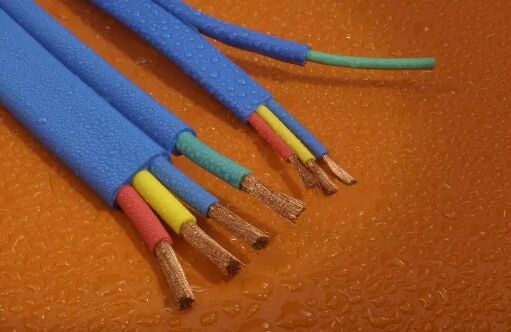By CONCEPT 119
A cable is an electrical energy or signal transmission device, an electrical device that can be used to transmit power, signals or data, usually consisting of multiple wires or optical fibers, and wrapped and protected by insulating materials and protective layers.cables and sensors

Cables have a wide range of uses and each use needs to be specially made. Its functions range from the transmission of electrical energy, electrical signals and wire products for the conversion of electromagnetic energy. Cables with a single core and a smaller diameter are often referred to as wires. A wire without an insulating sheath is called a bare wire. The core in the cable is made of a metallic material that conducts electricity well, usually copper, which is a good conductor, or aluminum, which is less expensive.
Different definitions of cable:
1. A wire made of one or more mutually insulated conductors and an outer insulating layer to transmit power or information from one place to another.
2. It is usually a rope-like cable twisted by several or groups of wires (at least two in each group). Each group of wires is insulated from each other and is often twisted around a center. Highly insulating overlay.
Ⅰ. Classification of cables
1. AC cable
The connection to the AC power is the AC cable, which is used to transmit the AC power.
2. DC cable
It is a power cable used in DC transmission and distribution system. The DC power transmission and distribution system usually runs on two wires (positive and negative poles), so DC cables are generally single-core cables.cables direct
Ⅱ. The main components of the cable
1. Insulation layer
2. Shielding layer outside the insulating layer: It is composed of metal foil or woven metal mesh, which is used to prevent external electromagnetic interference from affecting internal signals.
3. Sheath
4. Conductor: Made of conductive materials such as copper or aluminum, used to transmit current or light signals.
5. Other accessories
Ⅲ. Types of cables
Bare wire: Only the part of the conductor without insulation and protection.
Power cable: Power cable is a cable used to transmit and distribute electric energy. It is often used in urban underground power grids, outgoing lines of power stations, internal power supply of industrial and mining enterprises, and underwater transmission lines across rivers and seas.
Flame-retardant rubber-sheathed cable: Rubber-sheathed cable is a soft and movable cable variety that is made of multi-strand thin copper wires as conductors, and is covered with rubber insulation and rubber sheath.
Insulated wire: It consists of a conductive wire core, an insulating layer and a protective layer. There are several types of wire cores, such as single core, double core, triple core and multi-core.
Communication cable and optical fiber: It consists of two or more glass or plastic optical fiber cores, and uses optical fiber as a communication method as a transmission medium.
Ⅳ. Three major cable products
1. Cables for power systems
Power cables are cables used to transmit electrical power. It is composed of conductor, sheath, insulator and metal shielding layer. According to different application requirements and voltage levels, power cables have various types of specifications and structures, and play an important role in transporting power from power stations or substations to users or various power equipment. Low-voltage power cables are suitable for low-voltage distribution systems, medium-voltage power cables are used to transmit medium voltages, and high-voltage power cables are used to transmit high voltages.
2. Communication cable
Communication cables are cables used to transmit voice, data and video signals. Compared with overhead open wires, communication cables have the advantages of large communication capacity, high transmission stability, good confidentiality, and less affected by natural conditions and external interference.
3. Magnetic wire
Magnet wire is an insulated wire used to manufacture coils or windings in electrical products. Magnet wire can be classified according to its basic composition, conductive core and electrical insulation layer. Magnet wires are generally divided into enameled wires, wrapped wires, enameled wrapped wires and inorganic insulated wires.cables and wires
Ⅴ. Application category of cables
1. Communication cable
2. Power cables: cables used to transmit and distribute high-power electrical energy in power systems.
3. Network cables: There are three commonly used network cables: twisted pair cables, coaxial cables and fiber optic cables.
4. Overhead catenary
5. Winding wire: the conductive wire used to realize electromagnetic conversion. Such as enameled wire, wire covered wire and so on. It is often used in electromagnetic conversion equipment such as motors, generators, and transformers.
6. Control cable
7. Cable underground

Frequently Asked Questions
1. What are the advantages of using protective measures for cables?
Flame retardant, good heat resistance, can be used for a long time at 130 degrees without deformation, and will not burn in case of fire; good corrosion resistance, long service life, can be used in humid saline-alkaline areas; cable protection sleeves are either pipes or The pipe fittings have a certain degree of flexibility, which can resist damage caused by external heavy pressure and foundation settlement; the inner wall is smooth and does not scratch the cable. The design adopts the socket connection method, which is convenient for installation and connection.
2. What are the cable accessories?
Cable accessories are auxiliary components used to install, connect and protect cables. They can provide functions such as support, insulation, sealing, identification and protection of cables. Commonly used electrical accessories include steel plate junction slots, cable intermediate junction boxes, connecting pipes and terminals, cable trays, cable terminal junction boxes, etc.